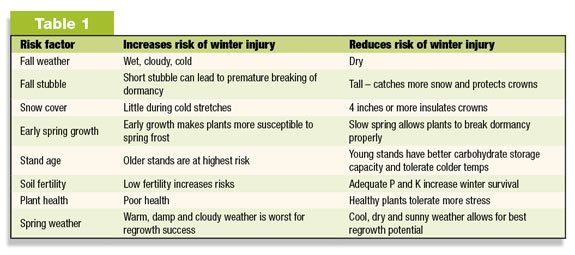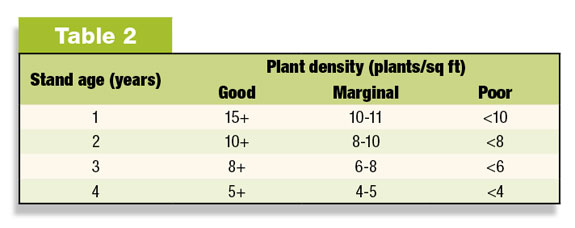While it will be too early to detect an injury, there will be several signs that will show potential winterkill or injury. The table below lists some of the different risk factors.

Evaluating a stand
Growers should carefully assess alfalfa plant health in the spring to help make decisions on keeping the stand or replacing it. An easy way to do this is with a “plant count” in the early stages of growth. This not only will give growers a better estimate on survival, but will also give a better idea of what the alfalfa stand will provide.
When counting plants per square foot around the field, count the number of plants (crowns) that are alive and healthy. Take four to five counts for every 10 acres. Record the plant counts and average for the field. The chart below lists stand recommendations.

The other option, the “stem count” method, is more reliable, but it forces you to wait several weeks after initial green-up. The three steps in this evaluation process are:
1. Check stands when alfalfa plants are 4 to 6 inches tall
2. Select four to five random one-foot square sites for every 5 to 10 acres
3. Count the number of stems per square foot
• If an alfalfa field averages more than 55 stems per square foot, it has top yield potential
• Some yield loss may be observed with 40 to 55 stems per square foot
• If the stem count is below 40 stems per square foot, consider replacing the stand.
It’s difficult to predict first-cut forage yield potential before spring because a large number of variables affect plant survival over winter.
Research indicates two variables best predict first-cut yield potential: winter temperature fluctuations (i.e., the number of times the mean daily air temperature rose above and fell below 31 degrees on days with less than 6 inches of snow cover) and spring growing degree accumulation (base 38.5).
When evaluating an alfalfa field for winter injury and future yield performance, check weed pressure as well. High infestations of grass weeds will greatly reduce forage quality. If a you need a consistent supply of high-quality forage, don’t tolerate of grassy weeds.
Dealing with winter-injured fields
When alfalfa fields suffer significant winter injury, growers have three options:
1. Kill the stand outright and plant full season corn
2. Harvest first crop alfalfa and double crop forage sorghum or corn for silage
3. Leave marginal alfalfa stands for the entire year
Studies show it’s best to plow a poor stand and plant corn for silage. This will allow a grower to meet the farm’s forage needs and utilize the residual nitrogen more efficiently.
If the field has a legume-grass mix and the grass is in good condition, a nitrogen fertilizer application can stimulate grass production.
Because of the potential for autotoxicity, growers shouldn’t interseed alfalfa in a field with an established alfalfa stand that’s over a year old. Research shows the area of autotoxicity influence is in a 16-inch radius from the established plant. If the original stand is less than 12 months old (seeded spring 2011), interseeding into the existing stand may be possible.
Prepare for potential rotation changes. Plan rotation scenarios for replacing winter-injured alfalfa fields and hope you don’t need to use them. FG
Matt Laubach
Dairy Specialist
Pioneer Hi-Bred










